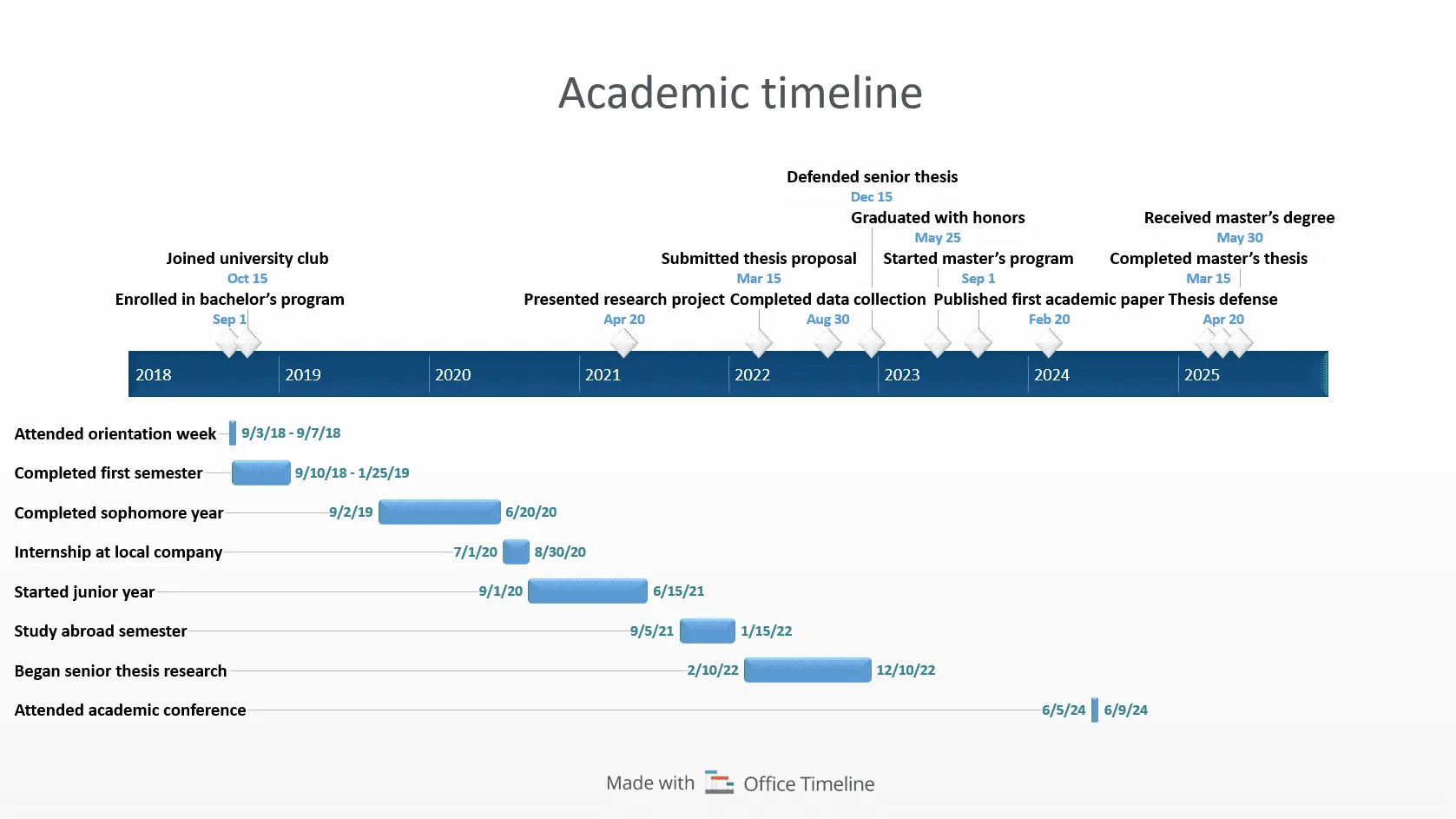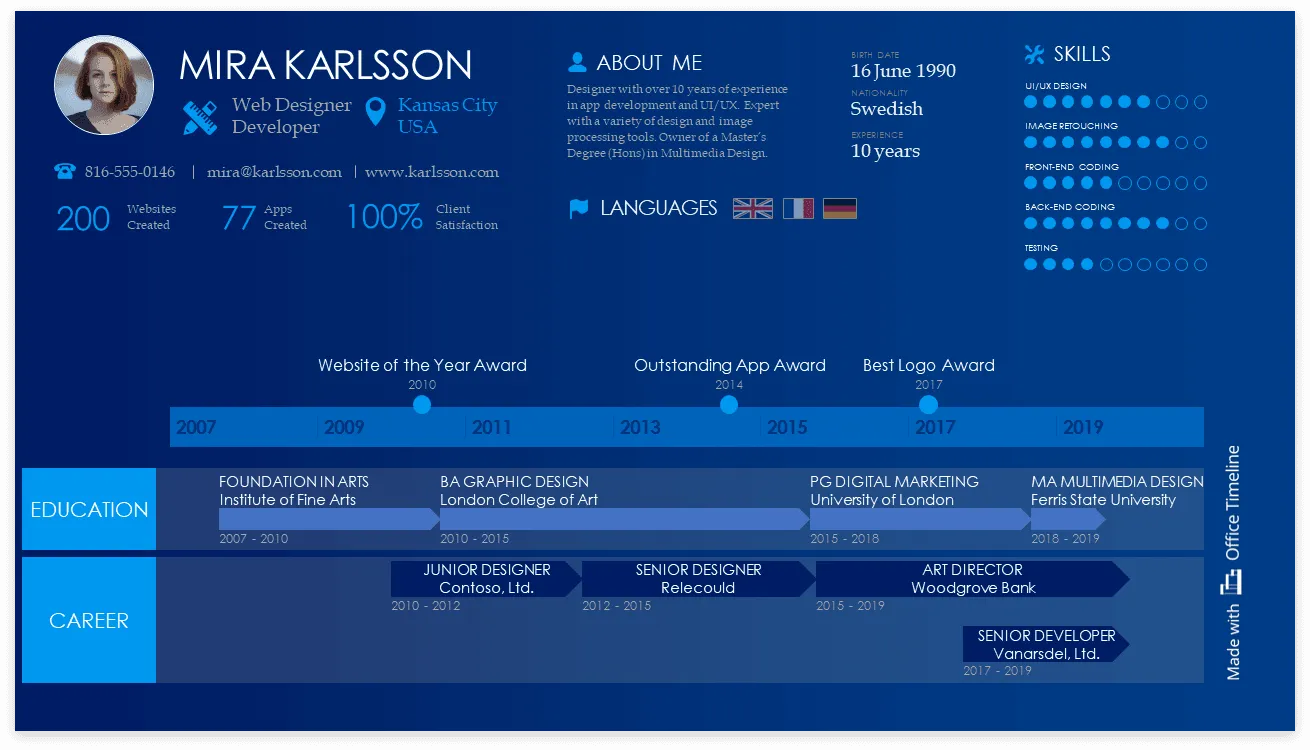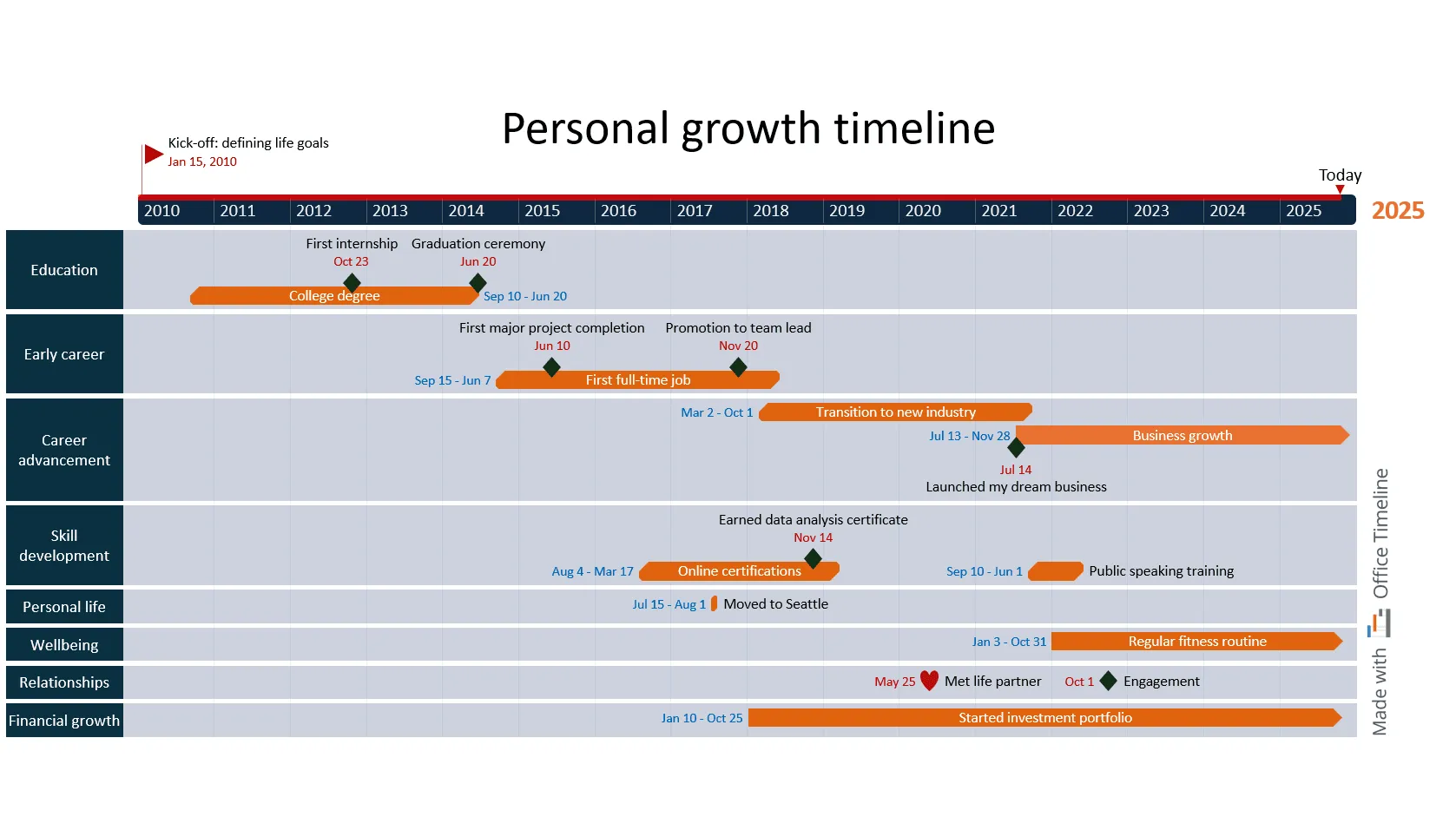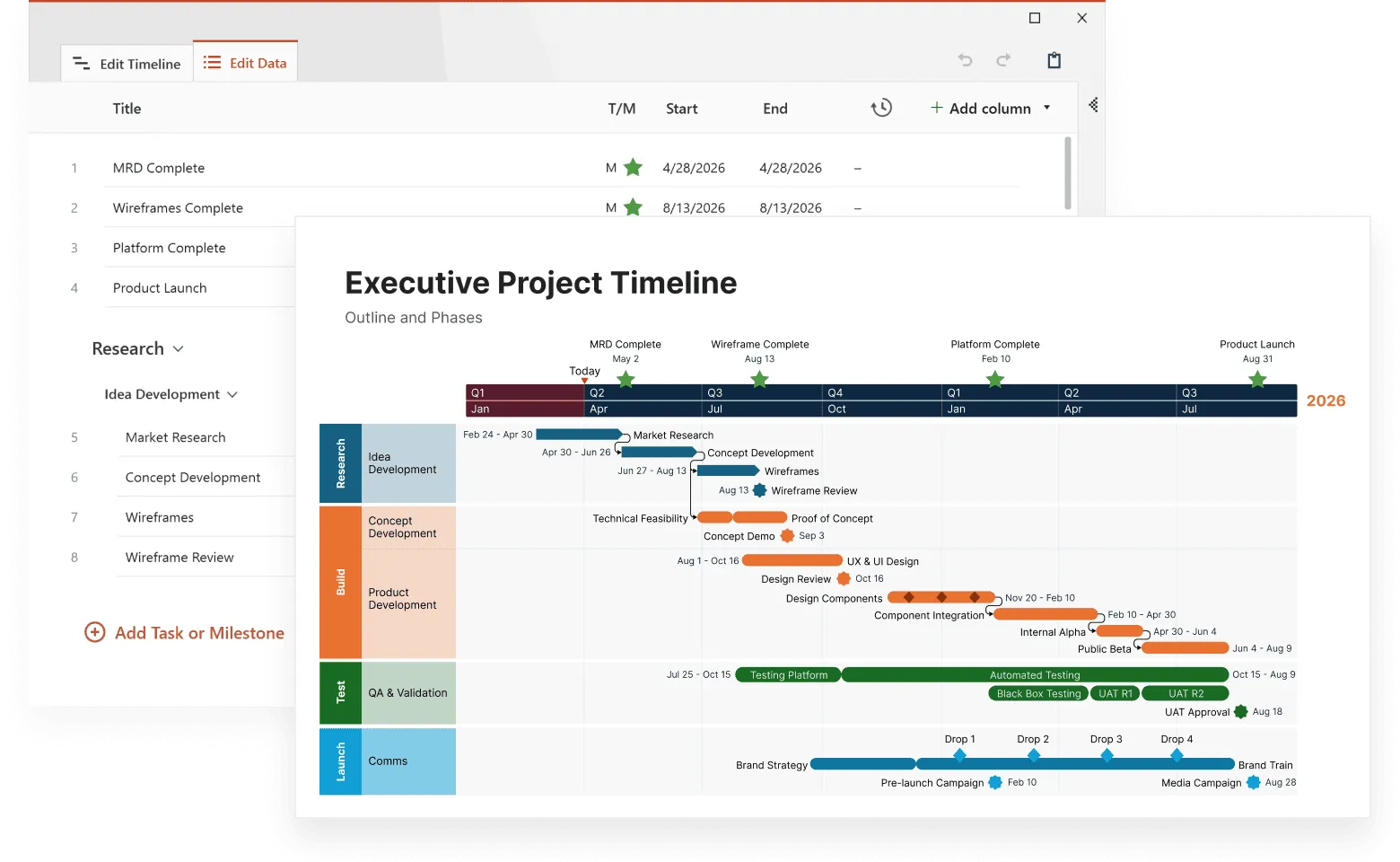Remember flipping through old photo albums and realizing how much has happened in your life? Creating a life timeline takes those scattered memories and arranges them into a story you can see and share.
This article shows you how to map out your significant moments in a way that makes sense to you. By organizing your experiences visually, you'll notice connections between events that weren't obvious before. You might spot turning points, recurring themes, or how certain decisions shaped later opportunities.
Whether you're curious about your personal history, documenting family stories, or focusing on specific chapters of your life, this guide together with our comprehensive resources on creating personal timelines will help you collect meaningful memories and design a timeline that truly brings your story to life.
Your life story, visualized
Life moves fast, and memories fade as time passes. The moments that shaped us, celebrations, losses, achievements, and turning points, start to blur together. How do we hold onto these experiences that made us who we are today? A life timeline works as a map of your life, with each important moment showing how your story unfolded step by step.
Think of each memory as a photo. When placed on a timeline, these moments link together to tell your whole story. You'll see when things happened, how they led to what came next, and how they helped shape who you are now. Making a personal timeline means taking time to look back, seeing how you've changed, and thinking about both the good times and hard times that moved you forward.
Let’s look at why making a timeline matters, what to include in yours, and easy ways to create one.
Why map out your memories?
Taking time to create a life timeline has real benefits. It gives shape to your personal history and shows your life's story in a clear, visual way that helps you better understand your path. When you record key moments, you gain insight into how you've developed and where you might be heading.
Looking at your own timeline helps you spot important connections between memories from different times in your life. This visual layout helps you set realistic goals, appreciate what you've accomplished, and recognize challenges you've overcome. It's a helpful tool for reflection, showing patterns that repeat and how you've grown through your experiences.
Your timeline has value beyond just what it means to you. It becomes something meaningful to share with family and friends, letting them connect with your story by seeing important events and the feelings tied to them.
Creating a timeline of your notable life experiences isn't just about looking back or keeping records, it's about engaging in something rewarding that has meaning for you now and for others in the future.
Types of personal timelines
Personal timelines come in different forms, each capturing unique aspects of your life. Here are some common types you might create:
- Life story timelines focus on key personal events and experiences that shaped who you are. These timelines highlight major milestones, turning points, and meaningful moments that make up your overall story.
- Family history timelines track genealogical information like births, marriages, and deaths across generations. They give you perspective on your roots and help pass down family heritage to children and grandchildren.
- Theme-based timelines concentrate on specific areas of your life. You might create one for your career path, showing job changes and achievements, or track your health journey over time. These focused timelines let you look closely at how you've grown in particular aspects of life. Whether you're documenting a major project or following your medical experiences, these specialized timelines clearly show your personal growth and changes.
Examples of creative life timelines
Timelines spark creativity in many ways. They let you map out all kinds of life events, from planning a wedding day schedule to tracking travel adventures. These examples show how flexible and creative timeline-making can be.
Creative timelines capture important milestones and key experiences well, whether showing an IT engineer's daily routine or a baby's first-year growth. They preserve special moments and major themes throughout your life journey.
Office Timeline's software works particularly well for these creative projects, offering templates that are easy to customize for personal stories while maintaining a clean, professional look that makes your memories stand out.
Academic timelines
Academic timelines track your educational journey through its key phases and accomplishments. They can include degree programs, significant coursework, research projects, internships, certifications, and graduations. By laying out these milestones chronologically, you can see how your knowledge and expertise developed over time.
These timelines are useful for students who want to reflect on their academic progress or for professionals who need to present their educational background clearly. They show not just what you studied, but when different pieces of your education came together, perhaps revealing how an early research project influenced later specialization, or how internships shaped your academic focus.
The example below was created in just minutes using the Office Timeline PowerPoint add-in, which makes it easy to design clear and professional visuals directly in PowerPoint. This academic timeline neatly illustrates the key phases of a student’s academic journey, from enrollment to graduation and postgraduate research, showing how each milestone builds on the previous one. With Office Timeline’s simple drag-and-drop tools, anyone can quickly build a polished academic timeline that transforms complex educational paths into a compelling visual story.
Career timelines
Career timelines offer a visual record of your professional journey, highlighting positions held, promotions earned, and important job changes. These timelines show how you've moved through different roles and reached milestones in your working life.
Creating a career timeline helps you see how your skills and job history have evolved. This visual outline helps you think about past work experiences and skill development. It also helps you plan future career goals with better clarity.
The professional templates in Office Timeline are especially useful here, as they're designed to showcase progression and achievement in a way that's both visually appealing and easy to understand.
The example above shows a beautifully designed career timeline created with Office Timeline, displaying both educational background and professional progression. Notice how the timeline effectively combines education milestones, career advancement, and professional achievements in one cohesive visual story.
This format makes it easy to see how education led to career opportunities and how experience built over time, perfect for resumes, portfolios, or professional networking profiles.
Personal growth timelines
Personal growth timelines track how different parts of your life develop and intersect over time. Instead of just listing career moves or personal milestones separately, you can map them together to see how they actually relate to each other.
When you look at education, work, relationships, health, and personal projects side by side, you start to notice things. Maybe that certification you got enabled a career change. Or moving to a new city coincided with both a job transition and starting a fitness routine. These connections aren't always obvious when you're living through them, but they become clear when you see everything laid out chronologically.
The timeline above shows a personal timeline that goes from 2010 to 2025 across multiple dimensions. What stands out is how non-linear growth actually is. Career advancement doesn't happen in isolation, it's interwoven with skill-building, personal relationships, lifestyle changes, and even decisions about health and finances.
You can see periods of intense focus in one area while others remain stable, and times when multiple aspects of life shift simultaneously. The gaps between events are as telling as the events themselves, showing that growth isn't constant or evenly distributed.
This kind of timeline reveals something résumés and social media don't: the actual pace and sequence of a life. Things don't happen when they're "supposed" to; they happen when circumstances, preparation, and opportunity align.
Steps to create your life timeline
Starting a life timeline might seem like a big task at first, but breaking it down into smaller steps makes it both fun and rewarding. Begin by deciding what you want to focus on. Will you map your entire life, look at just one decade, or focus on something specific like your career? Having a clear focus helps you include only what matters and avoid getting lost in too many details.
After you've decided on your purpose, the real work begins, choosing important memories to include, picking a format that fits your style, and designing something that looks good. Following these steps helps you create not just a record of events, but something meaningful that reflects who you are.
Step 1: Define your scope
Before you start building your timeline, decide what period or theme you want to cover. This helps you include relevant events without making it overwhelming. You might want to show your whole life, focus on a specific decade, or highlight just one area like your career growth or personal development. Setting these boundaries keeps your project focused and clear.
To give your timeline structure, identify specific start and end dates. Think about which moments deserve to be included within this timeframe. Consider talking to family members or friends who might remember important details you've forgotten, their input can add depth and meaning to your personal history.
Step 2: Gather your moments
Start by identifying the significant events and experiences that helped shape you. Look through photos, journals, and keepsakes to jog your memory. Make a list of these events with their dates as a foundation for your timeline.
Think about personal achievements, meaningful relationships, and major life changes that influenced you. Including emotional moments when you felt alone, confident, or empowered adds depth to your timeline. If you're missing dates, ask family members or look through old records for help.
After creating your initial list, set it aside for a few days. When you come back to it, you'll have a clearer sense of which events truly belong on your timeline, making sure it captures the most important parts of your life.
Step 3: Choose your format
Picking the right format brings your vision to life. There are many digital options, including templates and editable graphics. Tools like Canva offer easy-to-use interfaces and various file formats like JPEG, PNG, and PDF for creating and sharing your timeline.
If you prefer a hands-on approach, traditional pen and paper work just as well. Creating your timeline by hand can add a personal touch and creativity that digital methods might miss.
Choose a format that matches your preferences and complements your style, whether through modern technology or traditional crafting.
Step 4: Design and layout
The final step involves designing and organizing your timeline. Arrange life events in chronological order, from earliest to most recent, including dates, brief descriptions, and maybe photos or notes. This organization creates a clear path through your personal story that's easy to follow.
Make it uniquely yours by choosing different shapes, fonts, colors, images, and drawings. For the best arrangement, sketch out a draft first and then refine it as you go.
Remember, this timeline represents who you are. Make sure its design truly reflects your personality.
Bringing your timeline to life
Your timeline tells your story. Make it feel like you. When you add visual elements, you're not just decorating; you're creating triggers that transport you back to those moments. A simple icon of a graduation cap can instantly recall the pride you felt walking across that stage. A splash of color marking your wedding year brings back the emotions of that day.
Think about what each period of your life felt like. Maybe your college years deserve bold, energetic colors, while a period of loss or transition might be marked with softer, more contemplative tones. These color distinctions help you see patterns and phases at a glance.
Make it personal:
- Use your actual photos, even if they're imperfect. That blurry vacation snapshot holds more meaning than any stock image ever could.
- Add small symbols that only you would understand, like a coffee cup for the year you launched your business from a café, a tiny airplane for when you finally took that dream trip.
- Include brief notes or quotes that capture how you felt, not just what happened.
If you're using digital tools (like Office Timeline or similar software), take advantage of drag-and-drop features to experiment freely. Move things around until the visual weight matches the emotional weight. Your biggest milestones should look important.
The goal isn't perfection, it's authenticity. When you look at your finished timeline, you should feel something. It should be a mirror of your journey, not a corporate presentation. Every color choice, every photo placement, every symbol is a chance to honor your unique path.
Using your timeline for reflection and planning
Once your timeline exists, something remarkable happens: you start seeing your life as a story with themes, not just a random series of events.
What patterns emerge when you look back?
Maybe you notice that your biggest growth spurts came right after your most difficult periods. Or you realize you've changed careers every five years like clockwork. Perhaps you see that you're happiest when learning something new, and your timeline shows long gaps where you weren't challenging yourself. These patterns aren't always obvious when you're living day-to-day, but they become crystal clear when mapped out visually.
Use your timeline to ask better questions
- "Why did I thrive in that situation but struggle in this similar one?"
- "What was different about the years I felt most alive?"
- "Do I see any cycles I want to break or continue?"
This is not about dwelling on the past. Think of it like using your history as a compass. When you're facing a big decision, your timeline becomes a consultant. Considering a career change? Look back at other transitions. How did you handle them? What helped you succeed or what made things harder?
Planning forward with perspective
Your timeline also reveals something important: you've already overcome challenges you once thought were impossible. That job loss you feared? You navigated it. That relationship that ended? You healed. When you're setting new goals, this visual reminder of your resilience is powerful.
Instead of vague aspirations like "be more successful," your timeline helps you set goals rooted in who you actually are. If your timeline shows you've always been happiest when creating things, maybe your next goal should honor that pattern rather than fight it.
Keep it alive
Your timeline is a living document, not a museum piece. Update it when significant things happen, yes, but also revisit it quarterly or yearly. You'll be surprised how differently you interpret the same events as you gain distance and perspective. That "disaster" from three years ago might now look like a necessary redirect.
Your life is still being written. This timeline helps you become a more conscious author of what comes next.
Tools and resources for creating timelines
Using the right tools makes creating your life timeline much easier and more enjoyable. Some options provide ready-made templates, while others let you build something completely unique.
Digital tools
Digital platforms offer various styles and features to fit different preferences when making your timeline.
Popular programs include:
- Microsoft PowerPoint, which is easy to use and helps you create attractive timelines.
- Google Slides, offering a straightforward experience similar to PowerPoint.
- Canva's timeline tool, known for eye-catching designs and free templates.
- Office Timeline, if you want a polished, clean design without spending hours learning complex software.
These applications make creating personal timelines simpler. They let you show your style through graphics and share your timeline as PNG, JPEG, or PDF files. Whether you're new to design or experienced, these digital tools help you build sleek, well-organized life timelines.
Mention should be made on Office Timeline since it is especially worth trying if you want something that looks professional but don't want to spend too much time on the technical aspects. Their templates are specifically designed for visual storytelling, making them perfect for personal history projects.
Create your life timeline effortlessly
Try Office Timeline for free. Use ready-made templates to turn your milestones into clean, beautifully designed visuals in minutes.
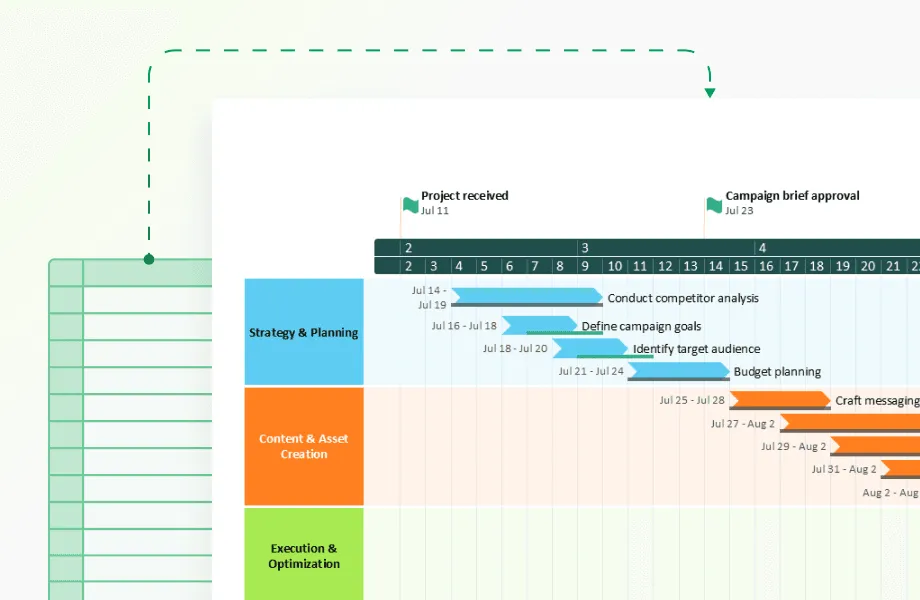
Analog methods
If you prefer a hands-on approach, traditional pen and paper work remarkably well for making personal timelines. Using craft supplies like markers, colored pencils, and decorative paper adds a personal touch to your project and makes the creation process more enjoyable.
Making a timeline by hand gives you creative freedom that digital apps sometimes lack. You can include drawings, handwritten notes, and artistic elements that reflect your unique personality and style.
This approach creates a deeper, more thoughtful connection as you physically piece together your timeline. The tactile experience of arranging and creating by hand often leads to more meaningful reflection on the events you're documenting.
Conclusion
Creating a personal timeline is a meaningful way to better understand your life journey. By mapping out notable events and memories, you can recognize your growth, spot patterns in your life, and set achievable goals for the future. We've explored different types of personal timelines, provided step-by-step instructions for creating them, and shared tools and resources to help bring your timeline to life.
A life timeline does more than just record dates and events. It's a powerful tool for reflection and planning ahead. Enjoy the process of creating your timeline. Let it celebrate the unique path that belongs only to you. Remember that visualizing your life's journey isn't just about noting past moments, but also about appreciating the special story your experiences tell together.
Digital tools like Office Timeline give you a polished, professional look, while handcrafted timelines offer personal touches and creative freedom. Your timeline becomes both a record of where you've been and a guide to where you're going. The simple act of organizing your memories into a visual story often reveals connections and meanings you might otherwise miss, giving you both appreciation for your past and clarity for your future.
Frequently asked questions
As you begin your journey of creating a personal timeline, you might have some questions about the process. We've gathered the most common ones to help guide you through mapping your life experiences. Whether you're just starting or looking to improve an existing timeline, these answers should help you create something meaningful and insightful.
Creating a life timeline helps you reflect on your personal journey and recognize your growth while setting realistic goals for the future. It shows you how far you've come and gives clarity about where you want to go next.
Include significant life events, personal achievements, and meaningful relationships that shaped who you are. Don't forget emotional experiences that had a strong impact on your journey.
You can create your timeline using digital tools like Office Timeline, Canva, Microsoft PowerPoint, or Google Slides. If you prefer a hands-on approach, traditional pen and paper work great too. Choose the method that feels most comfortable for you.
Make your timeline visually appealing by adding icons, illustrations, photographs, and color coding to distinguish different life phases. These visual elements bring your timeline to life and make it more engaging.
Update your life timeline regularly to keep it relevant and useful for ongoing reflection and planning. Adding new significant events as they happen helps maintain an accurate picture of your journey.


